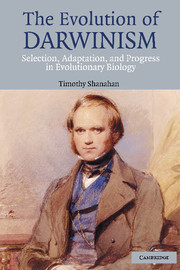Book contents
- Frontmatter
- Contents
- Introduction
- I SELECTION
- II ADAPTATION
- III PROGRESS
- 7 Darwin on Evolutionary Progress
- 8 Evolutionary Progress from Darwin to Dawkins
- 9 Is Evolution Progressive?
- 10 Human Physical and Mental Evolution
- Epilogue
- Appendix: What Did Darwin Really Believe About Evolutionary Progress?
- Notes
- References
- Index
7 - Darwin on Evolutionary Progress
Published online by Cambridge University Press: 18 December 2009
- Frontmatter
- Contents
- Introduction
- I SELECTION
- II ADAPTATION
- III PROGRESS
- 7 Darwin on Evolutionary Progress
- 8 Evolutionary Progress from Darwin to Dawkins
- 9 Is Evolution Progressive?
- 10 Human Physical and Mental Evolution
- Epilogue
- Appendix: What Did Darwin Really Believe About Evolutionary Progress?
- Notes
- References
- Index
Summary
It may be said that natural selection is daily and hourly scrutinising, throughout the world, every variation, even the slightest; rejecting that which is bad, preserving and adding up all that is good; silently and insensibly working, whenever and wherever opportunity offers, at the improvement of each organic being in relation to its organic and inorganic conditions of life.
(Darwin 1859, p. 84)Introduction
Considered as a whole, the two most striking aspects of the evolution of life on earth are the staggering diversity of living forms that have come into existence, and the fact that older forms have given way to new and improved forms that seem (for the most part) to be admirably adapted for their respective ways of life. Darwin captured both aspects of evolution in the closing words of the Origin, where he remarked that “from so simple a beginning, endless forms most beautiful and most wonderful have been, and are being, evolved” (Darwin 1859, p. 490). Although there are fascinating problems associated with the evolution of diversity (for example, why are there so many different kinds of living things? How do new species come into existence? What are “species,” anyway?), it is the second aspect of the evolutionary process that is at issue here. Life has not only diversified from its initial humble beginnings, it has also advanced. Multicellular organisms (“metazoa”) arose from unicellular organisms; mammals arose from earlier, nonmammalian ancestors; and in general larger and more complex organisms arose from smaller and simpler ones.
- Type
- Chapter
- Information
- The Evolution of DarwinismSelection, Adaptation and Progress in Evolutionary Biology, pp. 173 - 195Publisher: Cambridge University PressPrint publication year: 2004



